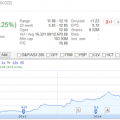For most investors, 2018 was likely a year to forget: global equity markets ended the year deep in the red and most fixed income sectors delivered muted returns. As we head into 2019, slowing global economic activity amidst elevated uncertainty and financial market volatility portend another bumpy ride ahead. Painful as 2018 was, we believe the challenging environment offered three important lessons for bond investors.
1.Mind the curve. Last year served as a reminder to bond investors that managing interest rate risk is not just about shortening or lengthening duration. Instead, what matters more is where on the yield curve you have exposure. Let’s examine 2018 returns for Canadian fixed income as an example. Looking at the full calendar year, short term bonds returned 1.37{01de1f41f0433b1b992b12aafb3b1fe281a5c9ee7cd5232385403e933e277ce6}1, outperforming long duration bonds (+0.31{01de1f41f0433b1b992b12aafb3b1fe281a5c9ee7cd5232385403e933e277ce6}2). Central bank moves were already mostly priced into the front end of the curve and rising rates made short duration bonds an attractive source of income. But taking a closer look at quarterly returns, we see a more nuanced picture. In 4Q2018, weaker global risk appetite led to major sell-offs across risk assets. Short bonds still performed well, delivering 1.37{01de1f41f0433b1b992b12aafb3b1fe281a5c9ee7cd5232385403e933e277ce6}3 but we saw the value of having duration as a portfolio ballast with long bonds returning 1.87{01de1f41f0433b1b992b12aafb3b1fe281a5c9ee7cd5232385403e933e277ce6}4 over the three months.
The takeaway: we continue to like the front end of the curve as a source of income. But if the fourth quarter was any indication of how things may unfold in 2019, incorporating some duration exposure could provide better ballast for the portfolio during a period of elevated uncertainty and financial market volatility.
2.Beware of late cycle dynamics. This brings us to lesson #2: be careful what you own as we enter a late-cycle phase. For most of last year, investors piled into lower-quality spread sectors like U.S. high yield (HY) and bank loans for their attractive yield levels. That changed quickly in the fourth quarter as risk appetite soured on increasing concerns about trade tensions and Fed policy tightening capping the end of the current business cycle. HY finished 2018 with negative returns of -1.51{01de1f41f0433b1b992b12aafb3b1fe281a5c9ee7cd5232385403e933e277ce6}5, with spreads widening over 100bps in just December alone. A similar story played out in bank loans, which finished the year virtually flat (+0.44{01de1f41f0433b1b992b12aafb3b1fe281a5c9ee7cd5232385403e933e277ce6}6) despite being up over 4{01de1f41f0433b1b992b12aafb3b1fe281a5c9ee7cd5232385403e933e277ce6} through October.
As the cycle matures, we prefer an up-in-quality stance in credit and believe investors should focus on risk-adjusted yield. Investors looking to build portfolio resilience can consider higher-quality credit exposures like investment grade floating rate bonds.
3.Be active: Heading into the late stages of the economic cycle, many investors are worried about a potential recession looming in 2019. While we do not think a recession is imminent, we believe periods of heightened volatility will continue to persist, underscoring the importance of building portfolio resilience while still taking advantage of tactical opportunities. For example, risk-off sentiment weighed on emerging market debt last year. But at some point, investors might consider tactically taking on some exposure if spreads get much wider and markets too heavily discount the asset class.
In summary, think about resilience, but keep an eye out for opportunities.
Rachel Siu, Director, Product Strategy team, is a regular contributor to the Canadian blog
Hersi Shima, Associate, is a member of the Product Strategy team within BlackRock’s Global Fixed Income group.
1 Source: Bloomberg, December 2018, based on FTSE TMX Canada Short Term Bond Index
2 Source: Bloomberg, December 2018, based on FTSE TMX Canada Long Term Bond Index
3 Source: Bloomberg, December 2018, based on FTSE TMX Canada Short Term Bond Index
4 Source: Bloomberg, December 2018, based on FTSE TMX Canada Long Term Bond Index
5 Source: Bloomberg, December 2018, based on IBOXX US Dollar Liquid High Yield Index
6 Source: Bloomberg, December 2018, based on S&P/LSTA Leveraged Loan Index
Index performance is for illustrative purposes only. Index performance does not reflect any management fees, transaction costs or expenses. Indexes are unmanaged and one cannot invest directly in an index. Past performance does not guarantee future results.
This material is not intended to be relied upon as a forecast, research or investment advice, and is not a recommendation, offer or solicitation to buy or sell any securities or to adopt any investment strategy. The opinions expressed are as of the date indicated and may change as subsequent conditions vary. The information and opinions contained in this post are derived from proprietary and nonproprietary sources deemed by BlackRock to be reliable, are not necessarily all-inclusive and are not guaranteed as to accuracy. As such, no warranty of accuracy or reliability is given and no responsibility arising in any other way for errors and omissions (including responsibility to any person by reason of negligence) is accepted by BlackRock, its officers, employees or agents. This post may contain “forward-looking” information that is not purely historical in nature. Such information may include, among other things, projections and forecasts. There is no guarantee that any of these views will come to pass. Reliance upon information in this post is at the sole discretion of the reader.
© 2019 BlackRock Asset Management Canada Limited. All rights reserved. iSHARES and BLACKROCK are registered trademarks of BlackRock, Inc., or its subsidiaries in the United States and elsewhere. Used with permission.
ICRMH0119C-704974-2/2
SOURCE: BlackRock Blog – Read entire story here.



